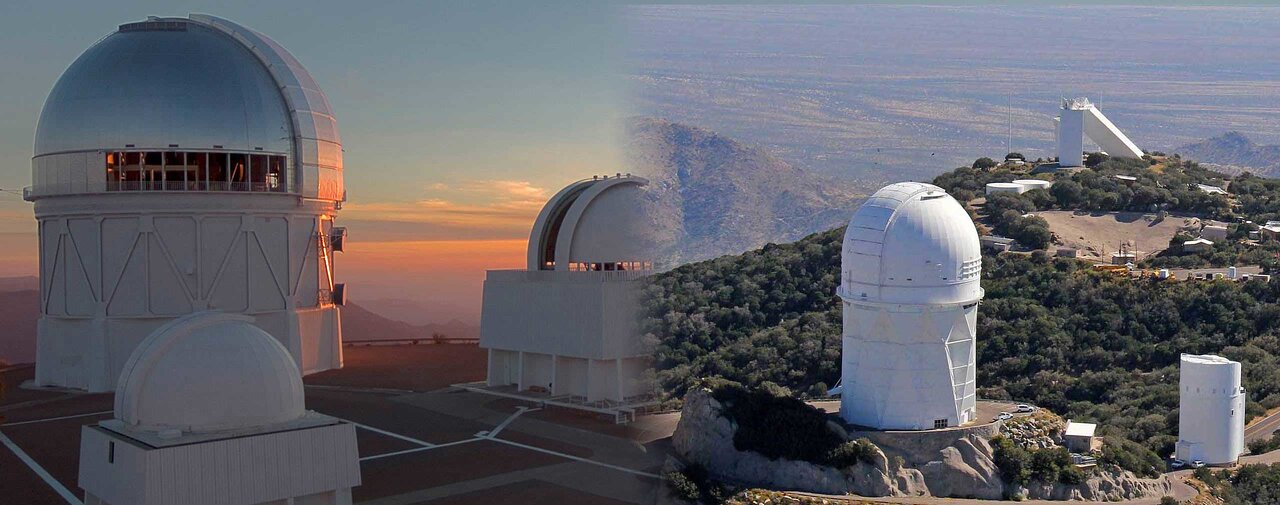History of NOAO
The creation of NSF’s National Optical Astronomy Observatory (NOAO) in 1984 consolidated under a single Director all of the ground-based observatories then managed by the Association of Universities for Research in Astronomy (AURA), including Kitt Peak National Observatory (KPNO, whose lease with the Tohono O’odham Nation was signed in 1958) and Cerro Tololo Inter-American Observatory (CTIO, whose site was selected 1962).
Over its 35-year history as the US national research and development center for ground-based optical and infrared astronomy, NOAO’s mission has been to develop world-class research capabilities for use by the professional astronomy community to conduct frontier science investigations. Research carried out with NOAO’s facilities has led to major scientific discoveries and explorations including:
- Flat rotation curves of galaxies and the existence of dark matter (1970s);
- First gravitational lens (1979);
- Accelerating expansion of the Universe and the existence of dark energy (1998);
- Dwarf galaxy companions and merger history of the Milky Way (ongoing);
- Dwarf planets in the outer Solar System (ongoing);
- Census and exploration of the Sun’s nearest neighbors (ongoing).
To enable these and future discoveries, NOAO has continuously created new opportunities to explore the Universe, advancing the way astronomers collect and interact with data. Since 1984,
- New telescopes have been created for community use, including: the WIYN telescope at KPNO (first light in 1994) and the SOAR telescope at CTIO (first observations in 2005), both developed in partnership with university consortia; the two Gemini telescopes (first community observations in 2001), developed through an international partnership; and the Vera C. Rubin Observatory (first observations anticipated in 2022), a public-private partnership involving an institutional consortium and an inter-agency collaboration between NSF and the Department of Energy.
- NOAO led the creation of software to process and analyze electronic data (e.g., the Image Reduction and Analysis Facility; IRAF — first public release in 1986). Just as CCDs changed the way astronomers collected their data, IRAF changed the way astronomers reduced and analyzed their data.
- The development of infrared array detectors at NOAO opened up the field of infrared imaging and spectroscopy to the entire astronomical community.
- The early recognition of the science potential of large surveys led NOAO to demonstrate their feasibility (with the NOAO Deep Wide-field Survey — begun in 1995) and to deploy increasingly powerful imagers (e.g., the Dark Energy Camera — commissioned in 2012 and supported by both NSF and DOE), data reduction pipelines that produce science-ready data sets, and opportunities for community-led surveys.
- NOAO’s long-term advocacy for massively multiplexed spectroscopy, another discovery frontier, has led to the Dark Energy Spectroscopic Instrument (DESI) experiment, now being installed and commissioned on the Kitt Peak Mayall telescope by an international collaboration led by Lawrence Berkeley National Lab.
- To meet the challenge of massive surveys such as Rubin, NOAO has developed software to analyze large data sets (e.g., NOAO’s Data Lab) and sift through the changing sky to find the most unusual time-varying objects (e.g., NOAO’s ANTARES — the Arizona–NOAO Temporal Analysis and Response to Events System), as well as systems to enable efficient follow-up studies of time-varying objects (e.g., AEON — the Astronomical Event Observatory Network — at SOAR).
- In collaboration with the NASA–NSF partnership on exoplanet research NN-EXPLORE, NOAO is about to install on the Kitt Peak WIYN telescope a state-of-the-art extreme-precision radial velocity spectrometer that will detect and characterize other worlds.
In part as a result of these developments, astronomy is today a more diverse enterprise than ever before, its pathways to discovery threading through projects, facilities, and teams both large and small. Future discoveries will be driven by large survey facilities such as Rubin, which will deliver massive data sets ready for exploration, as well as traditional investigations by curiosity-driven individuals and teams carrying out observational programs of their own design.
To meet the diverse needs of its community, NOAO has integrated with Gemini Observatory and Rubin operations, both of which were incubated in partnerships with NOAO, to create NSF's NOIRLab. The new lab is well-positioned to support the multi-faceted enterprise that will be ground-based optical-infrared astronomy in the coming decade.
Although the organizational name NOAO has been retired as part of the transition, NOAO’s mission and activities continue uninterrupted through KPNO, CTIO and the Community Science and Data Center (CSDC, which includes all of NOAO’s data, community coordination, community planning, and time allocation activities).
KPNO/CTIO Director Lori Allen remarked, “With the transition to our new organization, we will be able to support the diverse discovery modes of the future. We can also coordinate strategic planning across the broad array of laboratory facilities and services to better enable the US community’s continued leadership in astronomy.”
For CSDC Director Adam Bolton, “The new NOIRLab also creates an exciting opportunity for us to coordinate the data archives and data analysis systems that are essential for realizing the full scientific potential of our many observatories.”
